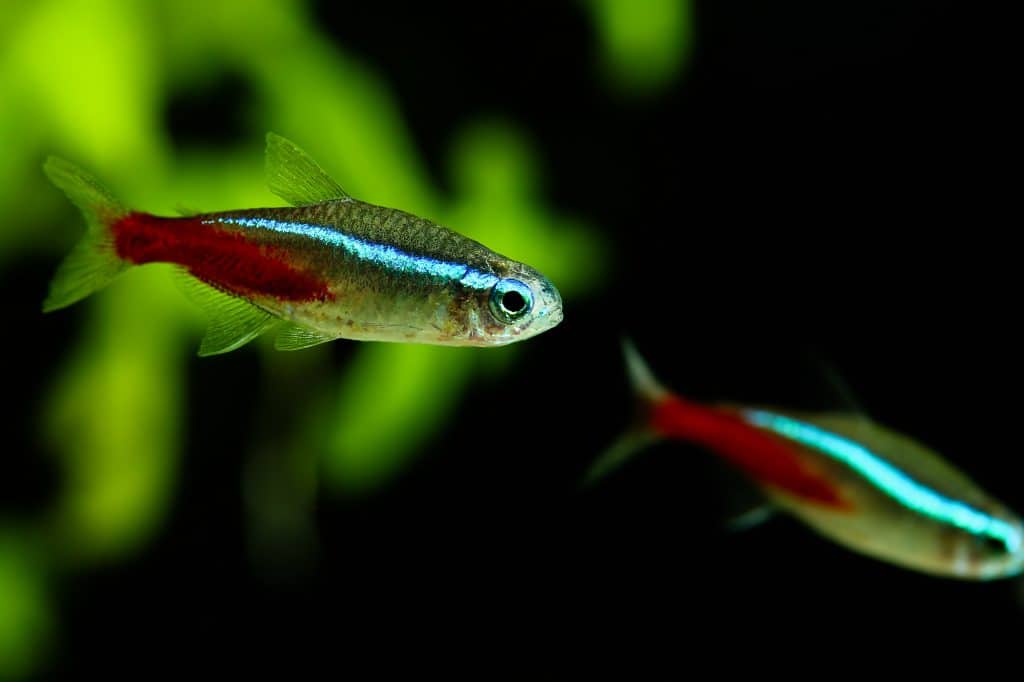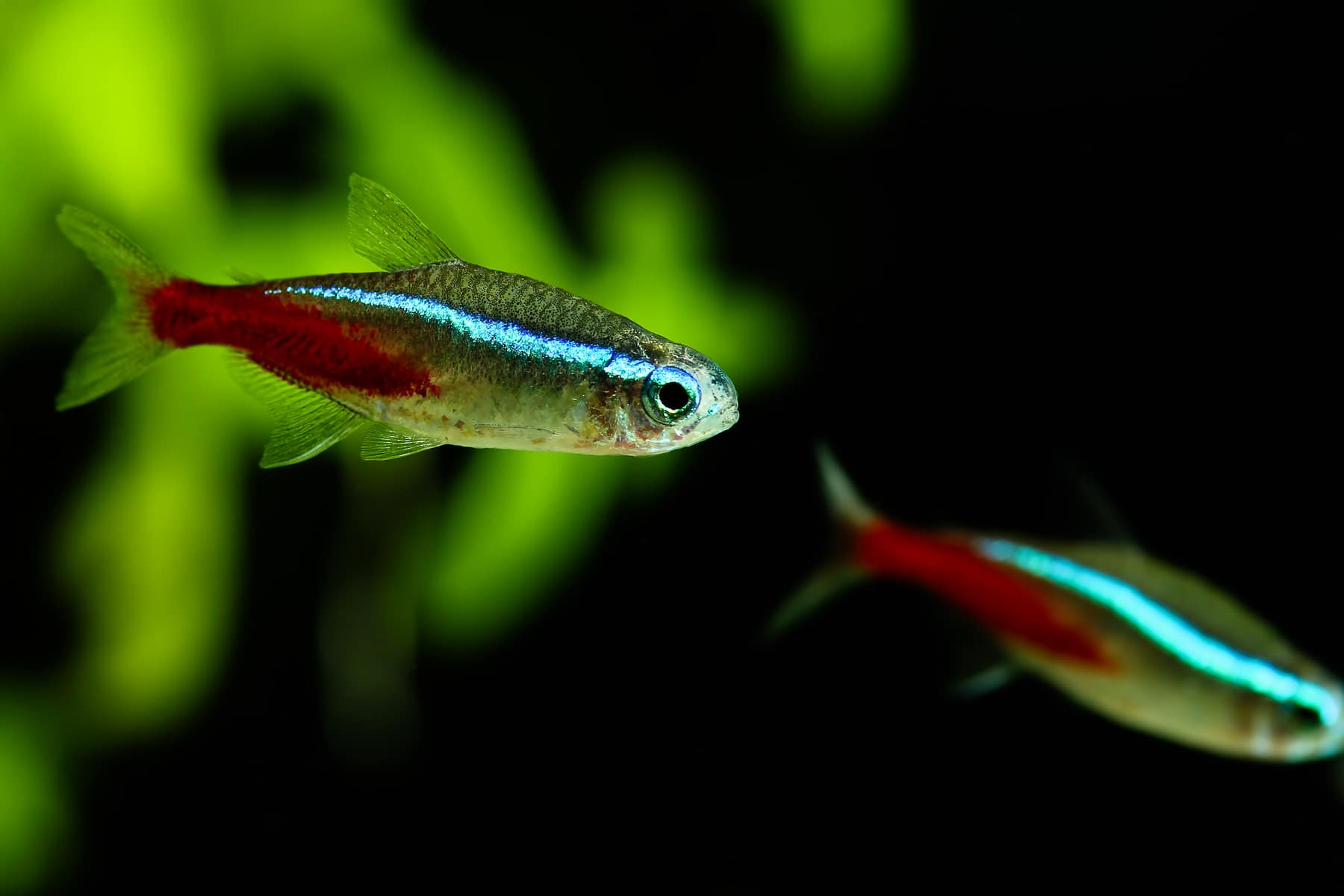As two of the most classic freshwater fish in the hobby, neon tetras and betta fish are some of the most common species to come across in aquarium setups. But what if you want both in the same tank?
Unfortunately, neon tetras aren’t the best tank mates for bettas due to differing temperature requirements and aggression, though some hobbyists have made it work so that both species live happily together.
Keep reading to find out why neon tetras don’t pair well with female betta fish or male betta fish and some alternatives that would be more compatible in your tank!
About neon tetras (Paracheirodon innesi)
Arguably one of the most favored species of the aquarium trade, the neon tetra is a fish that most hobbyists have had at one point or another in their tank. The simple, contrasting mid-lateral blue and red stripes of a school of neon tetras never cease to captivate an onlooker of the system; they are singlehandedly the main reason why many people get into the hobby in the first place.
Natural habitat
The neon tetra naturally comes from the Amazon basin throughout parts of Colombia, Peru, and Brazil. These forested areas have relatively moderate to low flow and tend to be a little cooler than normal tropical water conditions. Leaves and branches from the canopy above fall into the water and litter the substrate. Aquatic plants create areas of refuge for fish and other wildlife, while also contributing to the underlying detritus.
This detritus typically makes for blackwater conditions, where the water is stained brown from tannins. These tannins also make the water more acidic and provide some beneficial healing properties. In the aquarium, these conditions can be replicated by using Indian almond leaves or Indian almond leaf extract.
Neon tetra tank requirements
Neon tetras are a schooling fish and need to be kept in decent numbers in order to be the most active and forefront in the tank that they can be; it is recommended to keep at least 8 neon tetras together with more always being better. Since they can be pretty active fish and need to be in schools, a minimum tank size of 20 gallons (75.7 L) is suggested; just because these fish are small does not mean that they can be kept in a small tank!
Neon tetras need some special consideration since they are so small, especially when it comes to filtration. Many hobbyists–including myself–have learned the hard way that neon tetras will get sucked up into the filter no matter how much you try to prevent it. One of the best alternatives to a typical hang on the back filter, sump, or canister filter, is a sponger filter. However, sponge filters are only effective if water changes are kept up with and the tank doesn’t have an overbearing bioload. Otherwise, it would be best to get a mesh cover/other material to cover the intake of your filter to help stop neon tetras from getting sucked up.
Otherwise, these fish can be kept on a sand or gravel substrate with no problems. Neon tetras will appreciate natural decorations like rocks and driftwood. These little red- and blue-striped fish will also appreciate a densely planted tank where their colors will contrast with their deep green background; floating plants will especially provide extra hiding places and shade for fish and plants below.
Water parameters
These fish need a lower water temperature than most tropical fish and thrive between 68-78° F (20.0-25.6° C). They also tend to do better in more acidic water, with pH between 5.0-7.0. Indian almond leaves will help lower the pH and recreate blackwater conditions as they naturally occur in the Amazon basin.
Can you keep neon tetra with betta fish?
Most likely, you will not be able to keep neon tetra with betta fish. There are a few reasons why the two are simply incompatible.
Large tank
At the bare minimum, bettas can be kept in a 5 gallon (18.9 L) tank with a 10 gallon (37.8 L) tank being even better. On their own, neon tetras need a 20 gallon (75.7 L) tank. This would mean that a betta fish with a school of neon tetras would require 20 or more gallons to fit them both comfortably, and even then, aggression could still remain just as apparent.
Aggression
Betta fish are naturally aggressive fish, both male betta fish and female betta fish. They are especially aware of more colorful and active fish that might be mistaken as another betta trying to fight. While neon tetras have beautiful bright colors, they might be confusing to a betta fish and could lead to a fight!
While some hobbyists have never reported seeing aggression come from neon tetras, there have been been a few claims of neon tetras exhibiting fin nipping. If you have an especially lazy betta, it is possible that your neon tetras would take an interest and start nipping at longer fins.
Temperature differences
One of the biggest concerns between the two species is that they simply need different water temperatures. Neon tetras prefer slightly cooler conditions between 68-78° F (20.0-25.6° C) while betta fish need between 78-80° F (25.5-26.5° C). While two degrees might not seem a lot, it can make a huge difference for the physiology and overall health of both species.
This isn’t to say that some hobbyists haven’t had success keeping betta fish in a tank with neon tetras. If you are willing to lose a few fish (which we don’t recommend), then it would be best to have a tank larger than 20 gallons (75.7 L) that is well planted. It is also recommended to add the tetras to the tank first and add a female instead of a male betta fish. While female betta fish seem to be just as aggressive as most male betta fish, it seems that they are slightly more tolerable of tank mates being introduced.
Can betta fish kill neon tetras?
Yes. Bettas can and will kill smaller fish that they see as a threat. It is super important to do research on which tank mates will be compatible with your betta before you go out and buy it!
What other kinds of fish can live with a betta?
Luckily, there are a few other options, including fish, that can live with bettas perfectly fine!
Snails
Snails might not be the most exciting addition to a betta tank, but there is little to no risk that either will be harmed. Snails are also an important member of the aquarium cleanup crew and can help eradicate and prevent many species of algae from popping up in your tank. Some recommended snail species are ramshorn snails (Planorbidae family) and nerite snails (Neritidae family).
One or two snails can even be kept with a betta in a 5 gallon (18.9 L) tank!
Shrimp
Shrimp definitely bring more personality to a betta tank than snails but will need a little larger tank with 10 gallons (37.9 L) allowing for more space. Shrimp will greatly appreciate a densely planted tank with lots of hiding spots in the form of rocks, driftwood, and other decorations. Some recommended shrimp species are Amano shrimp (Caridina multidentata) and cherry shrimp (Neocaridina davidi); some hobbyists have even had luck keeping bettas with ghost shrimp (Palaemonetes genus), though this is usually pretty risky.
Make sure to check out our complete guide on keeping bettas with shrimp here!
Corydoras
One of our favorite fish to keep with bettas is the Corydoras catfish, mostly just referred to as cory catfish. These little fish usually stay towards the bottom of the tank, out of the way from where your betta will spend most of its time.
All cory species will need to be kept in schools; the best species for bettas seem to be the pygmy cory (Corydoras pygmaeus), which stays under an inch (2.5 cm) when fully grown. Pygmy cories can be housed together with a female or male betta in a 10 gallon (37.9 L) tank with little to no problems. Not only will they bring some extra excitement to your betta tank, but they will also help clean up detritus that falls and gets stuck in the substrate, helping prevent problems like brown algae from popping up in your tank.
Why Is My Betta Chasing Neon Tetras?
Neon Tetras Are New to Your Tank
When you have bettas in your tank and want to add neon tetras, beware- the betta will likely attack the neon tetras.
This is because bettas see other fish as a threat to their territory and often try to protect their space by chasing away or killing other fish.
Also, neon tetras are much smaller in size, so the betta will think they can easily overpower them.
Another problem is that neon tetras are very active fish, and this activity will likely trigger the betta’s chasing instinct.
Improper Male to Female Ratio
Bettas are very aggressive fish, especially if they don’t have a female betta with which to mate. If there are more males than females in your tank, the males will start chasing each other and any other fish in the tank.
Unfortunately, neon tetras are often subject to this aggression, as they are small and easily overpowered by the larger betta.
Neon Tetras Are Nipping Your Bettas
Neons are fin nippers by nature, and they bite the fins of other fish to establish dominance in the tank. Although this action is usually non-harmful, it can irritate bettas.
This is because bettas are very sensitive to nipping their fins, and even a tiny amount of damage can trigger a strong reaction. In an attempt to get them to stop nipping their fins, they will start chasing the neon tetras.
Will Neon Tetras Nip Betta Fins?
Neon tetras will likely nip at the fins of your betta fish. However, you can avoid this by adding plenty of plants and hiding places to your tank, which will give your bettas a place to retreat if they feel scared.
Diet
Neon tetras are omnivores, and bettas are carnivores, so while your neon tetras are eating a mix of foods, your betta is only interested in eating meat.
Thus, you can offer high-quality pellets or flakes to them and supplement their diet with live or frozen foods like brine shrimp, daphnia, or mosquito larvae.
In case you don’t have access to live food, you can give them frozen or freeze-dried foods. However, make sure to soak them in water for a few minutes before feeding to avoid indigestion.
In addition, you can offer them bloodworms, but only in small doses. When you feed them too many bloodworms, they can become constipated and develop swim bladder illness.
Finally, it would be best if you left blanched veggies in your tank for your neon tetras once in a while. However, ensure you remove them within one day, or they’ll start to decay and pollute your tank water.
Tips for Housing Neon Tetras & Bettas Together
Add Neon Tetras First
A betta fish will quickly establish a territory once placed in a new tank. If you add any other fish to the same tank, there is bound to be a fight as he protects his turf.
To prevent this from happening, you should add your neon tetras to the tank first. This will give them a chance to establish their own territory before the betta fish try to claim the entire tank as their own.
Add a Variety of Hiding Spots
Both these species may benefit from hiding places. When your betta is around other schooling fish, it feels more secure when it can quickly escape to a hiding place.
You can create these safe locations using plants. If the foliage is thick, bettas can readily move from leaf to stem and back again.
Among other possibilities, you can use driftwood and stone caves. Some of them are already available for purchase, while others you may have to prepare yourself.
In case you choose driftwood, I suggest picking a thick piece and making it hollow with a drill.
Are Neon Tetras Able to Consume Betta Fish Food?
Since neon tetras are omnivores, they can eat betta food. The ideal diet for neon tetras consists of fish flakes and vegetables, while the diet for bettas comprises betta pellets and meat. Hence, these fish can both eat live foods like shrimp and worms.
Will Neon Tetras Ever Attack Bettas?
It’s unlikely that neon tetras will attack betta fish. However, they may nip at the fins of your Betta if they feel threatened or confined.
Even when your bettas attack them first, neon tetras will only attempt to defend themselves or just swim away.
FAQ
How many neon tetras can I house in a 3-gallon tank with a betta?
While you can technically put 2-3 neon tetras in a 3-gallon tank, I wouldn’t recommend it. This is because they won’t be able to establish a territory and will likely be bullied by the Betta.
Also, feeling confined can trigger aggression in Neon Tetras, so they may start nipping at the Betta’s fins.
How many neon tetras can you put in a 5-gallon tank with a betta?
None! Even if the tank was set up with both species in mind, 5 gallons (18.9 L) is still just enough space to house a betta, let alone other fish tank mates.
How many neon tetras can you put in a 10-gallon tank with a betta?
Again, none. The bare minimum for trying to keep neon tetras with betta fish is 20 gallons (75.7 L). With a 10 gallon (37.9 L) tank, snails, shrimp, or Corydoras are much better options.
How to know your neon tetras are healthy?
When you buy neon tetras, choosing the healthiest fish is essential. A sick fish will not only suffer but can also infect other fish in your tank.
Here are some signs that your neon tetra is healthy:
- Clear, bright eyes
- Smooth scales
- Even body shape
- High activity level
- High appetite
Conclusion
While your dream aquarium might be a mixture of neon tetras and bettas, this setup simply won’t work. Neon tetras require a larger tank that can minimize aggression between the two species. Differences in ideal water temperatures also make it so that neither the betta nor tetra would ever be truly comfortable.
There are a few better alternative tank mates for bettas, like snails, shrimp, and even small Corydoras. Make sure to do some research before you make any final decisions!
If you have any questions about neon tetras, bettas, or have had experience keeping either species, don’t hesitate to leave a comment below!












